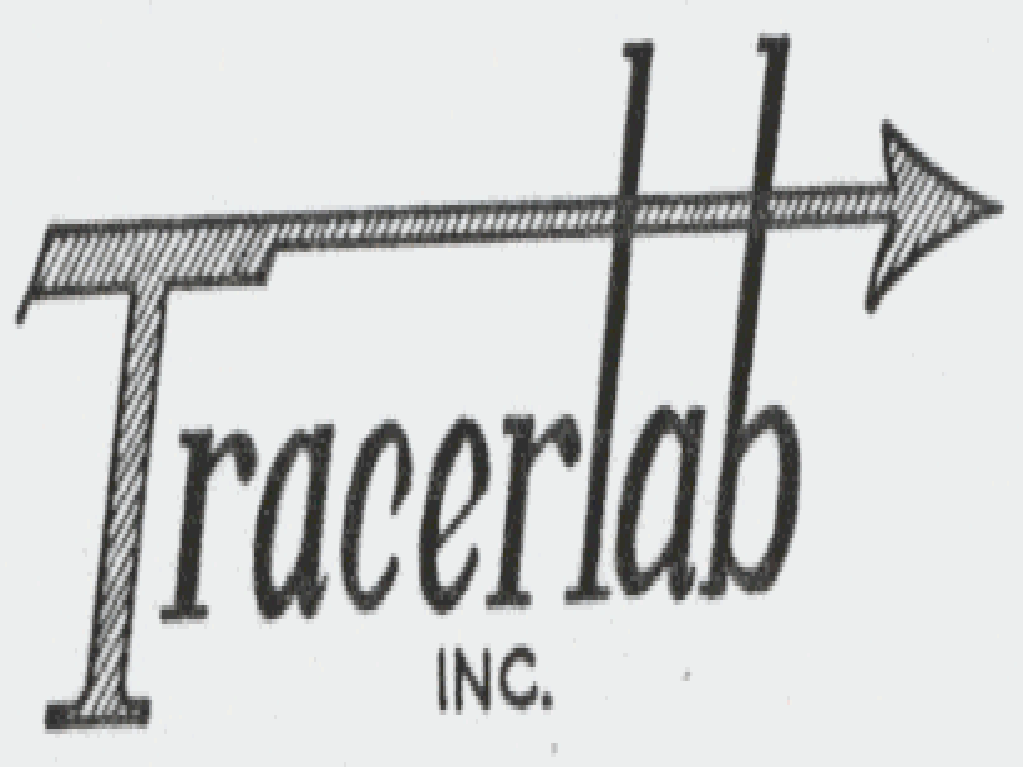
Tracerlab Incorporated
Tracerlab was started in 1946 by Bill Barbour in Cambridge, MA, offering a variety of electronic products including portable instruments. Within a few years, they developed a line of health physics instruments including the Chalk River type Cutie Pie. Tracelab purchased Kelley-Koett X-Ray Corporation in 1951. Tracerlab was originally located at 55 Oliver Street in Boston, Massachusetts. In 1948, Tracerlab has distributors in six foreign countries. They later moved to 130 High Street in 1950. In 1950, the Tracerlab Western Division was opened at 2295 San Pablo Ave in Berkeley, at 221 North LaSalle St in Chicago and 1175 Broadway in New York. Later in 1951, Tracerlab was located at 1030 Wright Avenue in Richmond, California. The original Oliver Street location soon grew to encompass seven different locations in the downtown Boston area. In 1957, the entire operation moved to Waltham, MA.

Tracerlab Logo

Tracerlab Address 1948

Tracerlab Address 1953

Tracerlab Address 1955
The Model SU-1 was a portable beta and gamma radiation meter that was a redesigned version of the recently declassified Cutie Pie. It was a true Roentgen dosage meter. The Cutie Pie was the first portable survey meter to employ a pistol grip. The Cutie Pie first appeared in 1944 at Oak Ridge National Laboratory and Hanford. The exact location of its first development is not known.
The Tracerlab Model SU-1 was introduced in 1948. It has an ionization chamber which is 3 diameter x 6 long, constructed of bakelite tubing with aquadag inner coating. The chamber is 540 cubic centimeters and had a rod along the axis as the collecting electrode. It was designed for use in hot laboratories handling radioactivity of the order of millicuries or hundreds of Rutherfords. It has a small meter and three-decade ranges from 100 to 10,000 mR/h. The thin nylon window at the end of the chamber permits entry of beta less than 0.1 MeV and x-rays down to 50 keV. It has a permanently mounted rotary bakelite shield which can be moved over the ion chamber to eliminate all betas. It uses four 1.5, two 7.5 and four 30 volt batteries. The unit cost $275 in 1948. The unit measures 13 x 4 x 12 and weighs 4.5 lbs.
The SU-1 Cutie Pie unit was modified and introduced later in 1948 as the SU-1A (IM-5/PD) for the military. It has a larger 3 meter and three-decade ranges from 25 to 2,500 mR/h. It was designed for radiation shipments, experimental setups, and x-ray machines. The chamber was 3 x 6 made of bakelite tube coated with aquadag. It could measure down to x-ray energies of 50 keV. The unit was 6.5 x 3 x 5 and weighed 4.5 lbs. It sold for $275.

Tracerlab Cutie Pie Model SU-1 Ad 1948
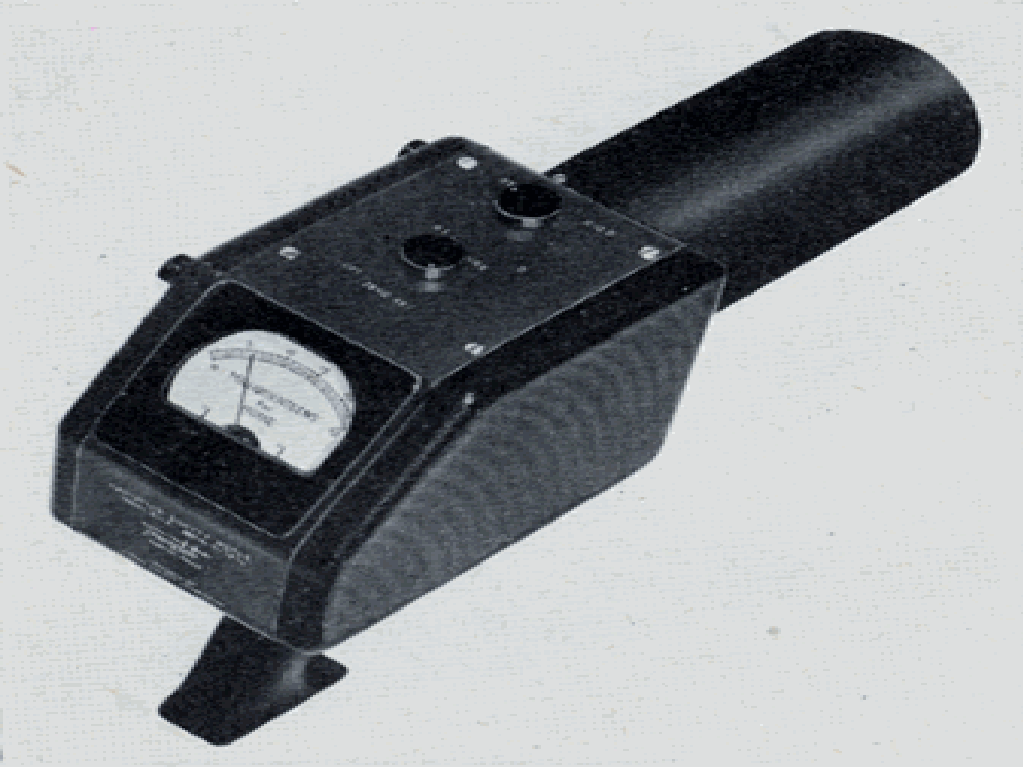
Tracerlab Cutie Pie Model SU-1A 1948
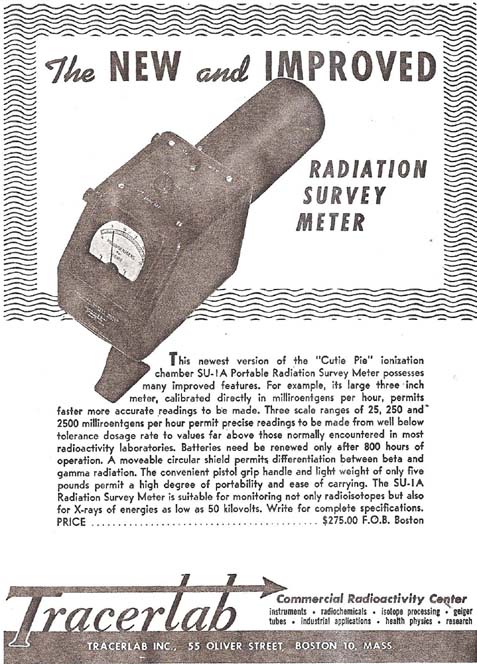
Tracerlab Cutie Pie Model SU-1A Ad 1948
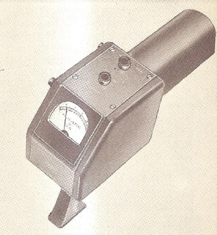
Tracerlab Cutie Pie Model SU-1A 1950
The Tracerlab Model SU-1B was introduced in 1950. It was a portable survey meter in the well-known Cutie Pie configuration. It could measure from 25, 250 and 2,500 mR/h. The instrument was 4 wide x 6 long x 5 high and had a chamber which was 3 diameter x 6 long. It had a 5 long pistol grip. It used two 7.5, four 1.3, and four 30 volt batteries for the ion chamber. The end of the chamber has a pliofilm window to permit measurement of betas. It had a black anodized aluminum finish with a dull black finish on the bakelite chamber. The price was $275 in 1950.
Need photo
Tracerlab Cutie Pie Model SU-1B 1950
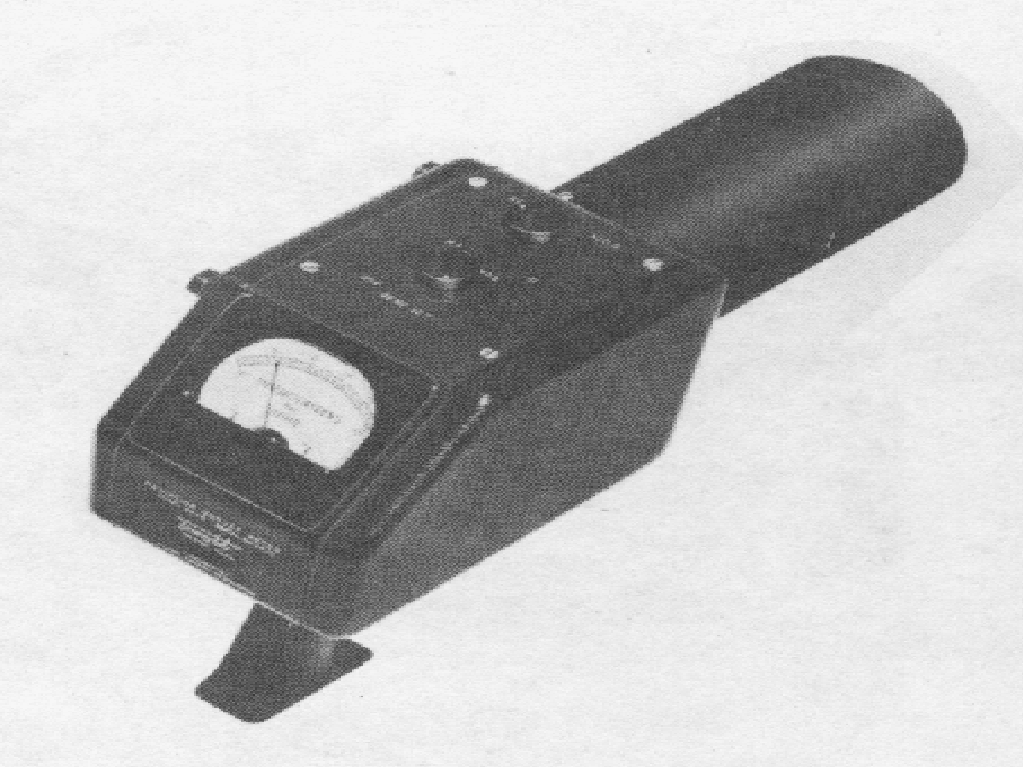
Tracerlab Model SU-1C 1950
The Model SU-1E was introduced in 1951. It employs new circuitry for inverse feedback for extremely stable operations and a reduction in the time constant to 1.5 seconds. It was designed for use in hot laboratories (millicurie activities) where increasing ranges are required. It uses an ionization chamber as the sensing element. It has three ranges of 15, 150 and 1,500 mR/h are available. The ion chamber is made of Bakelite, coated inside with aquadag. The end window is made of pliofilm to allow entry of beta particles down to 100 keV. The window has a rotary shutter to screen beta radiation. The unit was 12 x 10 x 3 and had an ion chamber which was 3 diameter x 6 long and a volume of 0.4 liters. It had a large 3 meter. It has three controls On-Filament-Off for warm-up and operation, Zero for zeroing scale, and Selector for the range scale. The unit had a dark gray-blue finish. The SU-1E sold for $275.
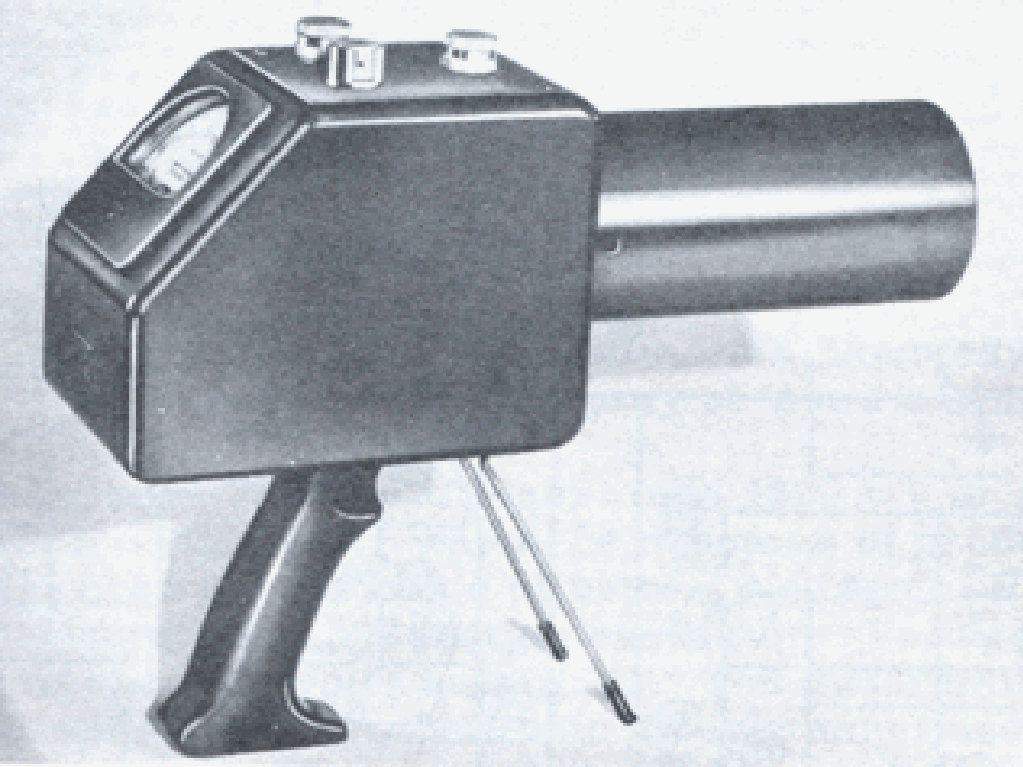
Tracerlab Model SU-1E 1951
In 1954, Tracerlab introduced the Model SU-1F. It was a Cutie Pie Survey Meter with three ranges of 25, 250 and 2,500 mR/h. It was similar in shape and size of the Model SU-1E but much improved. The sensitivity was increased, the stability improved, and the meter response time increased. The unit sold for $275 in 1954.
Need photo
Tracerlab Model SU-1F 1954
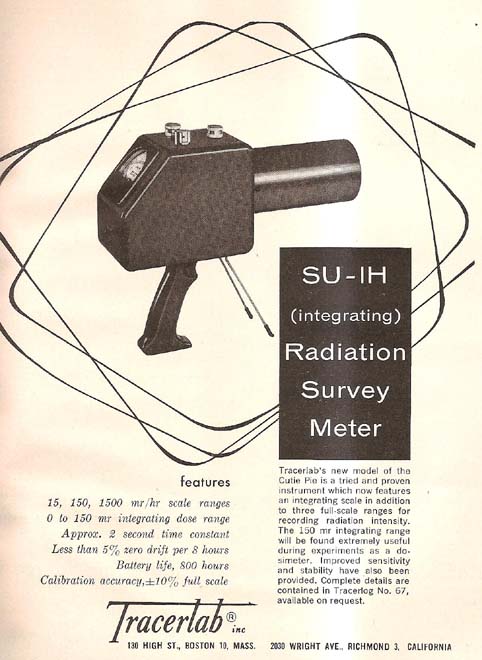
Tracerlab Model SU-1H 1955

Tracerlab Model SU-1N
The SU-3 Laboratory Monitor was introduced in 1948. It was designed for routine contamination monitoring. It has 3 ranges from 200 to 20,000 cpm. It comes with a thin mica window Geiger tube enclosed in a probe with a 4 cable. It is stored on a clip on the side of the unit. It has a meter on the front and also a aural speaker. The front panel measures 9 x 12 with a 9 depth. It weighs 17.5 lbs. and operates on AC power. The unit sold for $285.
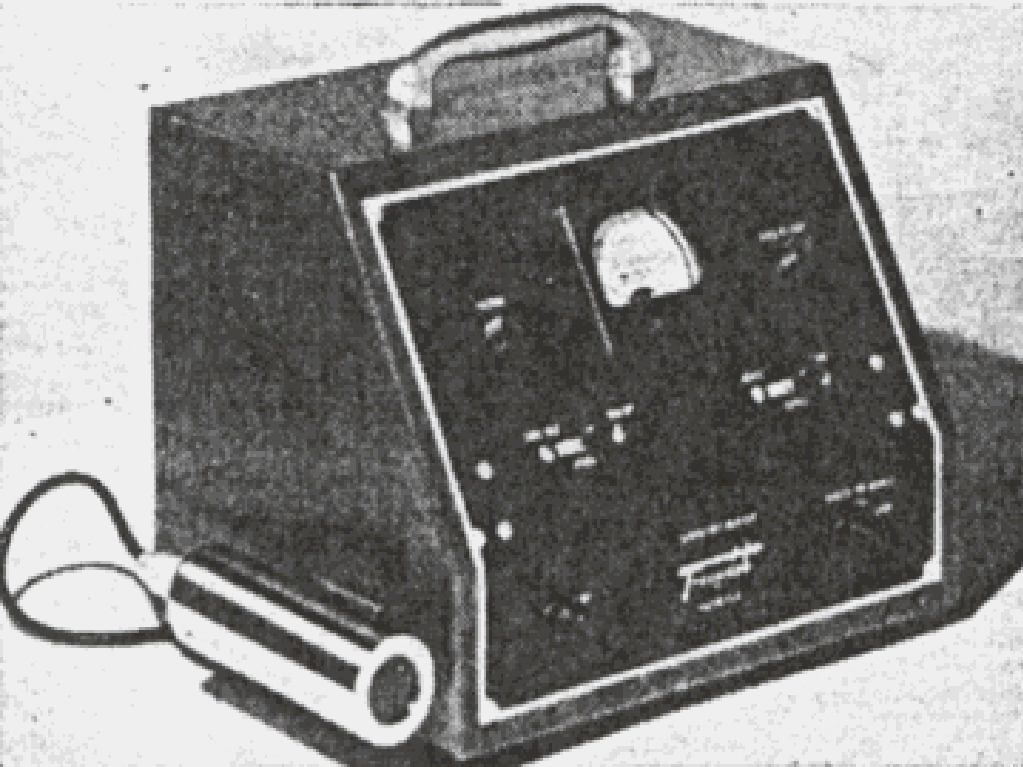
Tracerlab SU-3 1948
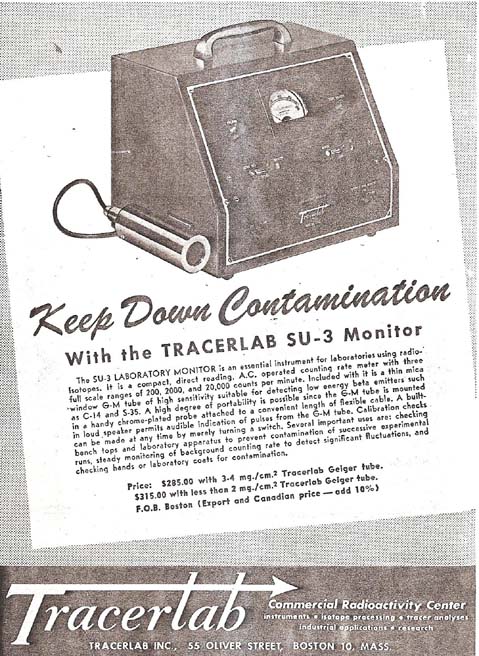
Tracerlab Model SU-3 Ad 1948
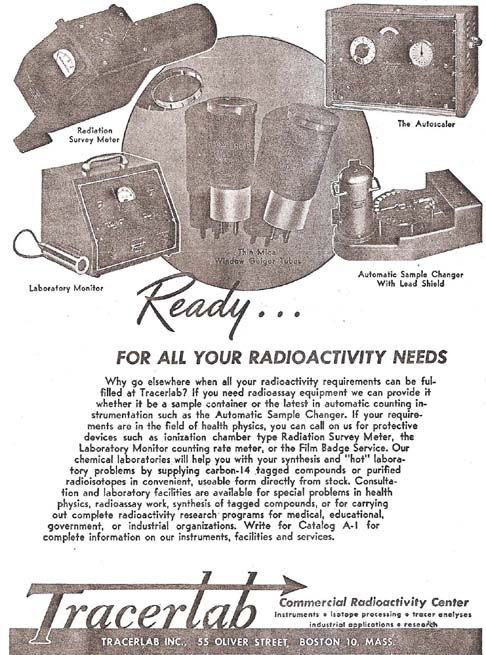
Tracerlab Detector 1948
The Model SU-3A was offered in 1950 as a laboratory monitor with a GM tube in an external probe with a mica window. The unit measures 9 x 12 x 9 and weighs 17.5 lbs. It detected betas and gammas with ranges from 200, 2000 and 20,000 cpm. The high voltage was adjustable from 1200 to 1500 volts. It had a loudspeaker and meter for indications. The unit operated on AC power. The instrument is housed in an attractive walnut cabinet with a sloping front aluminum panel. The unit sold for $285 with the TGC-1 Geiger tube or $310 with the TGC-2 Geiger tube with a thinner window.
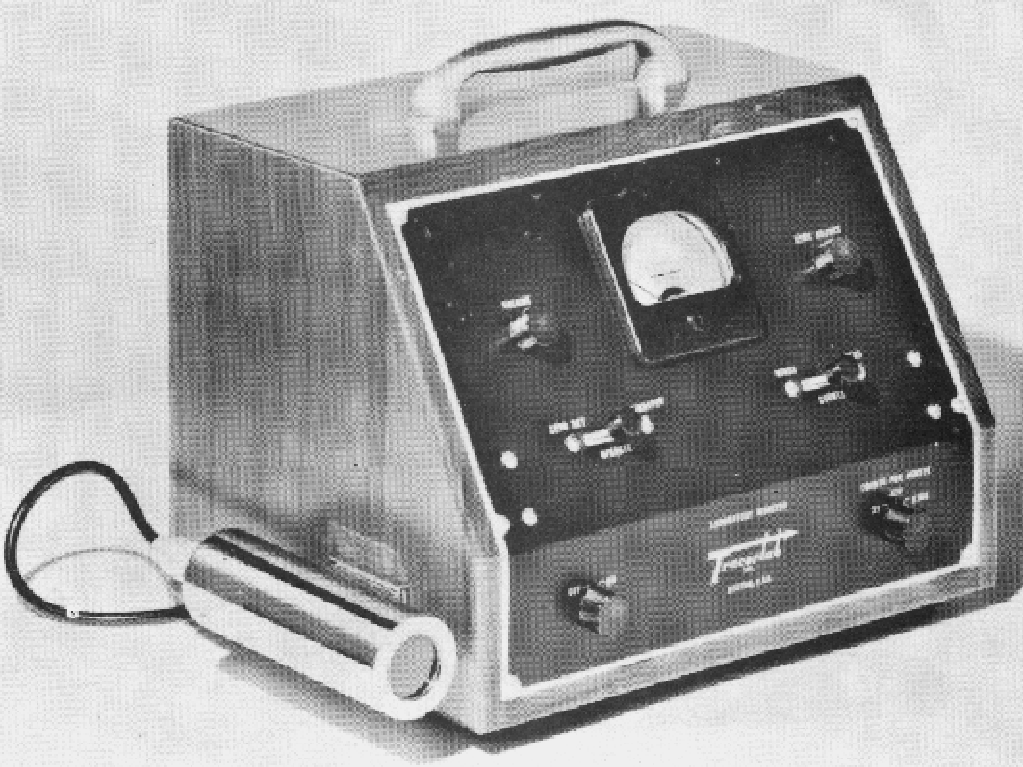
Tracerlab Model SU-3A 1950
The Model SU-3B was introduced in 1951. It had a simpler and better method of high voltage control and was developed for routine contamination monitoring. It has three ranges from 200 to 20,000 cpm. It comes with a mica end window Geiger tube enclosed in a probe assembly. It has a built in loudspeaker in rear with volume control on front panel. It could also drive a chart recorder.
The Model SU-3B Laboratory Monitor was introduced in 1951. It was the ideal routine contamination and background monitor. It is equipped with a mica end window GM tube enclosed in a detachable probe assembly. An optional alpha probe was available. It has a loudspeaker with volume control. It had three scales of 200, 2000, and 20,000 cpm. It will detect very low energy beta emitters such as C-14 and S-35 as well as alpha with a thin window tube. A built in pulse generating circuit, synchronized with the 60-cycle line frequency, allows calibration checking without the use of an external generator. It had a large 4.5 meter. The unit was 9.5 x 12 x 9.5 and had a walnut cabinet, chrome plating with a panel of light gray with black markings. The unit sold for $275 to $285 depending on the probe.
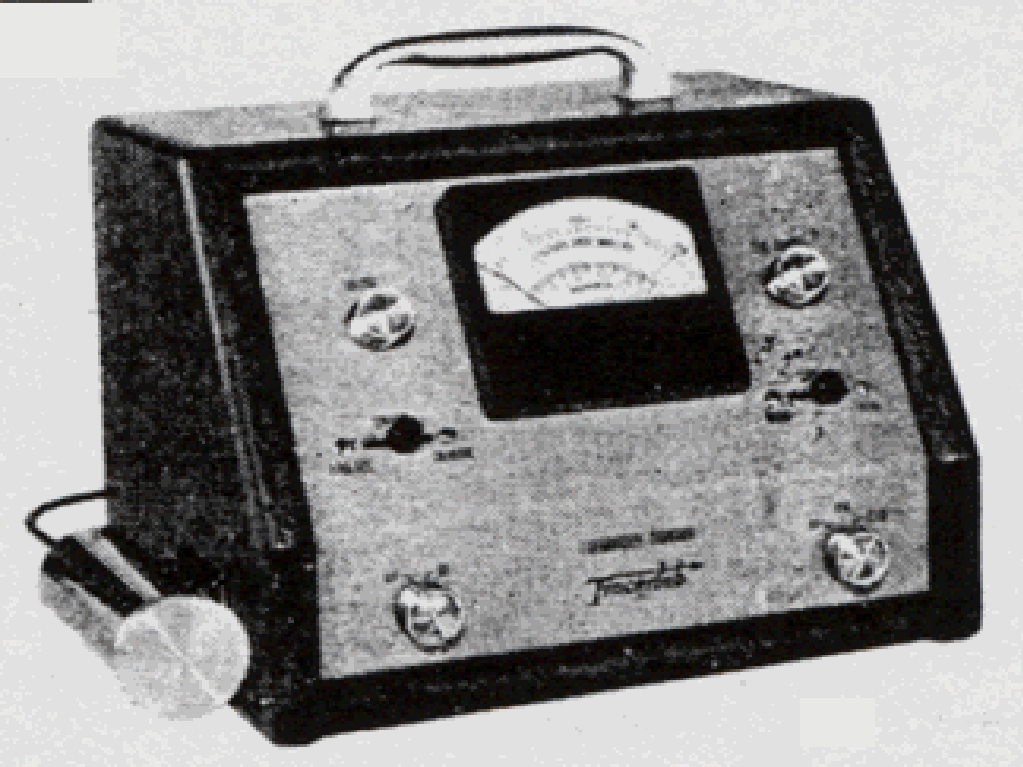
Tracerlab Model SU-3B 1951
The Model SU-3C was introduced in 1954. It similar to the SU-3B but with improved features and a new front panel. It also has an aural monitor. The high voltage ranged from 500-1800 volts to accept a variety of probes. It could also accommodate a recorder. It operated on AC power. It was 10.75 x 13.75 x 12. The cabinet had a dark gray-blue top with light gray sides. The panel was dark gray-blue with aluminum markings. The probe was chrome plated. The unit sold for $315-$325 depending on the probe.
The Model SU-4 was introduced in 1948 as a Radioactivity Demonstrator for classroom experiments with an internal GM tube for detecting betas and gammas. It had a removable shield on the front cover for detecting betas. The meter full scale is 2,500 cpm. The Geiger counter tube can be varied from 500-1100 volts. It came with a beta and gamma source for demonstrations. It had three means of indicators loudspeaker, flashing neon light and a counting rate meter. It sold for $90 in 1948 and included unit, sources, instruction manual, experiments and lectures notes.
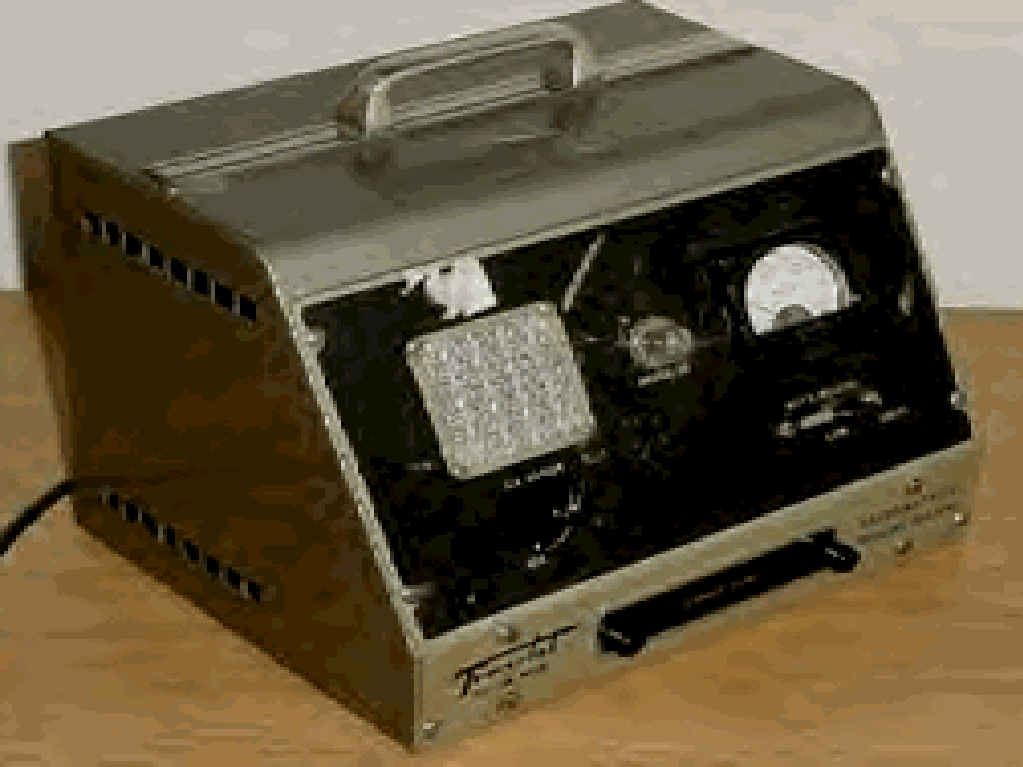
Tracelab Model SU-4 1948
The Model SU-4A was offered as a classroom Radioactivity Demonstrator for teaching in high schools in 1949. It had a beta gamma tube mounted inside the front of the unit. The Geiger tube had a removable cover for beta detection. It had a loudspeaker, neon flashing light and a quantitative meter for indications. It could measure up to 2,500 cpm. Tube voltage could be varied from 500-1100 volts and it operated on 110 AC power. The unit came with 2 grams of lead chlorate containing radioactive lead-210 as a pure beta source and 1 microcurie of cobalt-60 for a pure gamma source. The unit was 8 x 10 overall and had a silver-grey hammertone enamel case with etched markings and raised satin aluminum lettering on a smooth black baked enamel panel. The unit weighed 14 lbs. and sold for $112.50 in 1950.
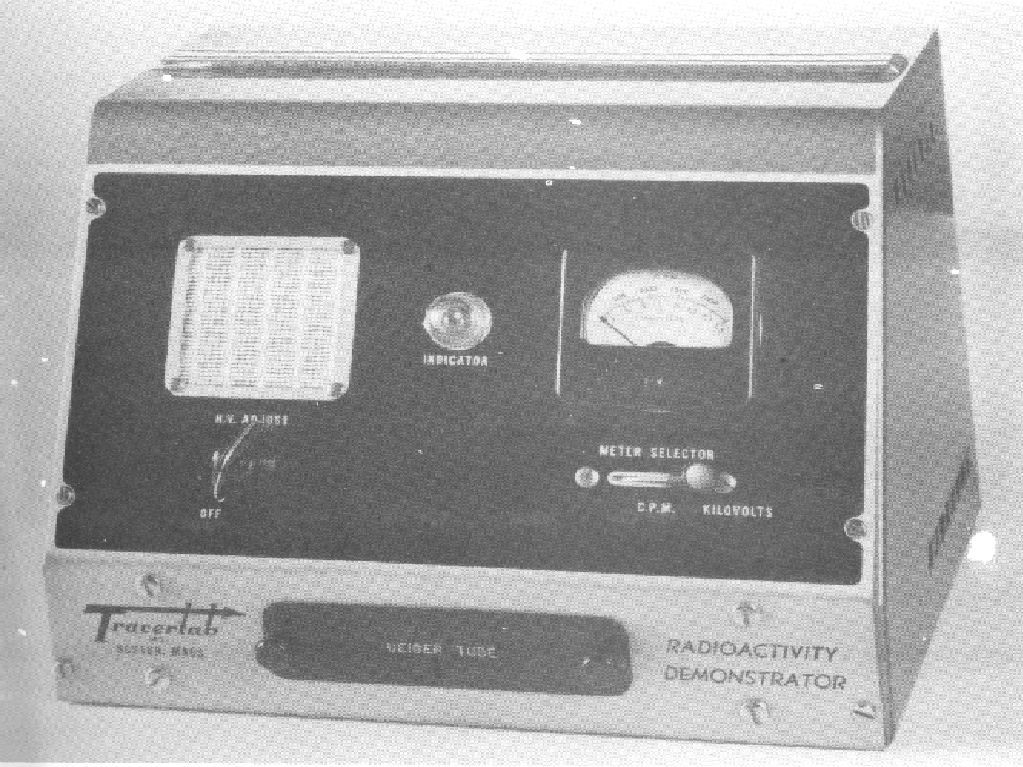
Tracerlab Model SU-4A 1950
The Model SU-4C Radioactivity Demonstrator had an external GM tube for teaching basic principles of radioactivity in classroom lectures. It was introduced in 1951. The unit detected betas and gammas up to 2,500 cpm. The case is light gray-blue with a dark gray-blue panel. It came with a pure gamma and beta source for demonstrations. The unit has a large 4.5 meter, a loudspeaker and a neon flashing light. The unit was 8 x 10 x 8 and operated on AC power. The unit sold for $128.50 in 1951 and $179.50 in 1954. The unit was also sold by Central Scientific as Model 71225.
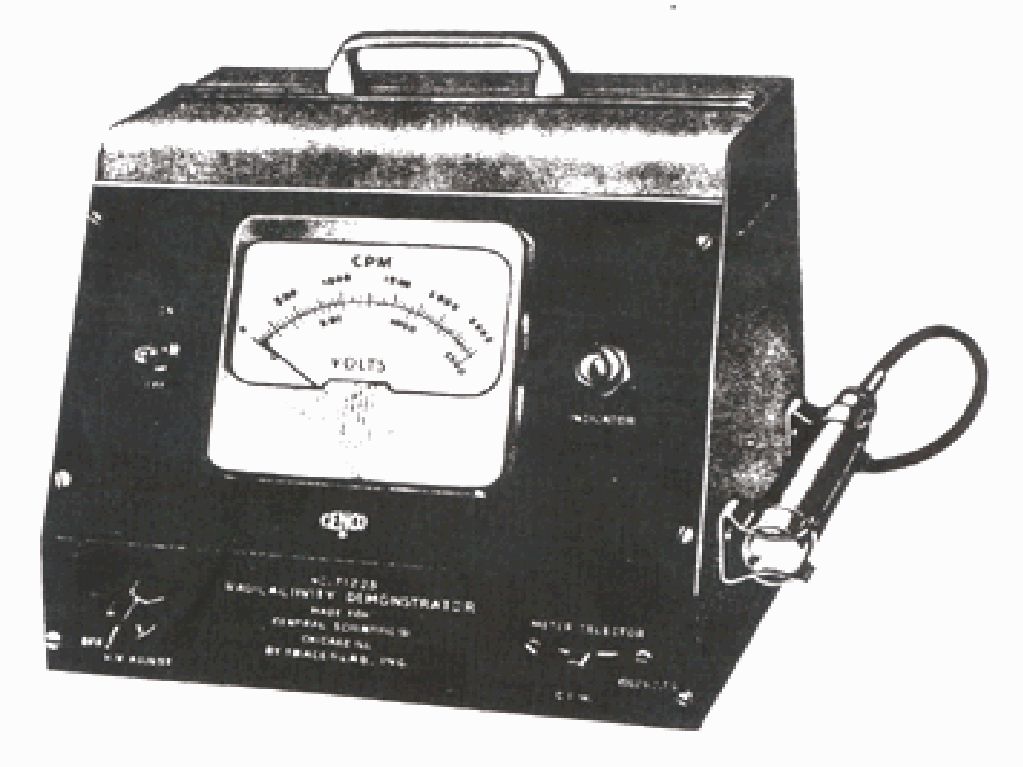
Tracerlab Model SU-4C 1952
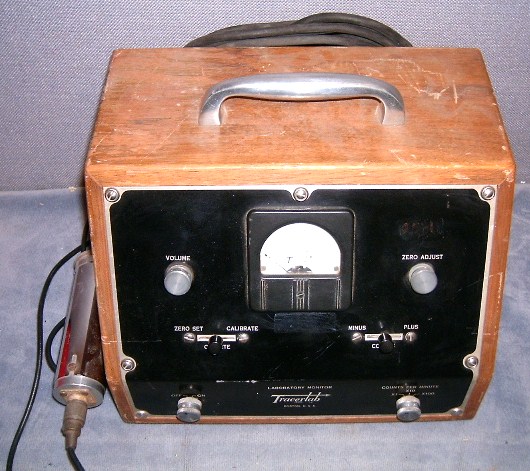
Tracelab Model SU-6A
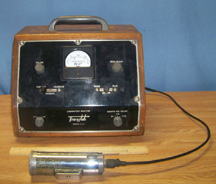
Tracelab Model SU-6A
The Tracerlab Model SU-5 was introduced in 1950 as a beta-gamma survey rate meter. It has a meter calibrated in both mR/h and cpm. It has four ranges from 0.02-20 mR/h and the corresponding scale of 100-100,000 cpm. It had a TGC-50 glass walled Geiger tube enclosed in a removable probe with a beta window. The probe was 1-3/8 x 8 long and was chrome plated brass with a removable shield. The shield will eliminate up to 2.5 MeV betas. With the shield removed, the probe has a metal cage with a 53% open area. It is sensitive to betas and gamma above 0.3 MeV can be measured.
The Tracelab Model SU-5 can operate with the TGC-5 plug-in beta-gamma Geiger tube. It has a thin window for betas. It uses two 1.3, one 67.5, and three 300 volt batteries. The unit was 10 x 5.5 x 6 and weighed 11 lbs. 14 oz. It sold for $235 in 1950.
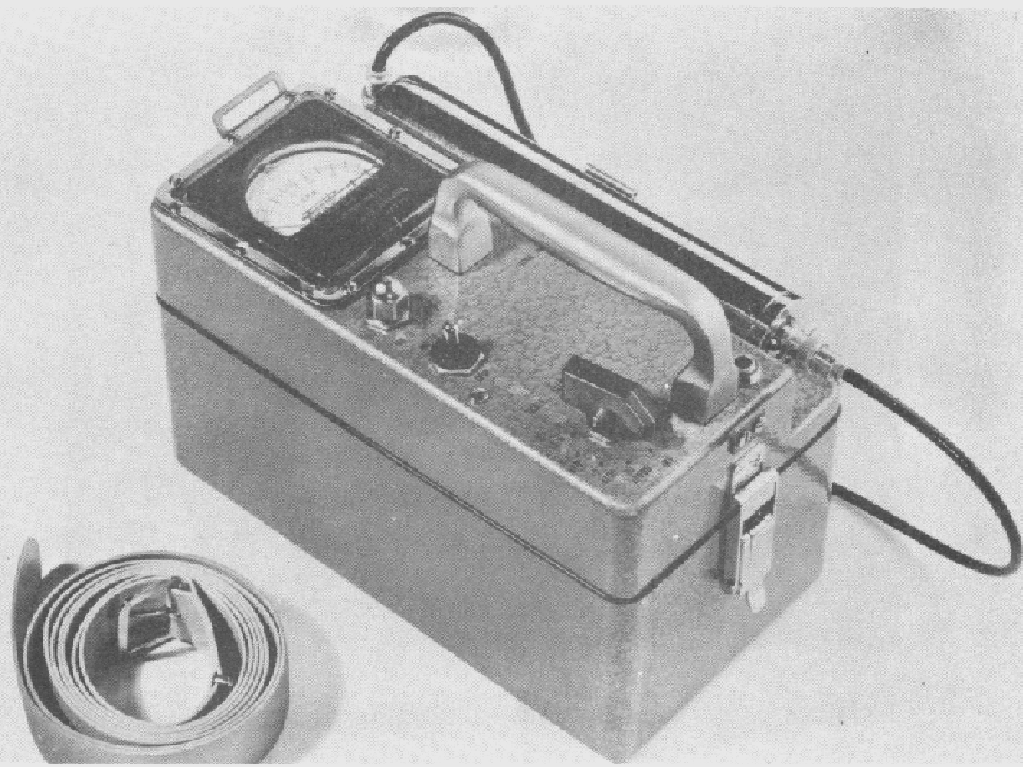
Tracerlab Model SU-5 1950
Tracerlab introduced the Model SU-5A which has an auxiliary probe in 1951. It is a lightweight radiation survey and counting meter. It comes with a P-17 Side Window Probe. The window is thin enough to allow high-energy betas above 300 keV to be detected. A shield can be rotated on the probe to shield betas up to 2.5 MeV. An alternate probe, the P-18 End Window Probe, has a mica end window which permits detection of low energy alpha and beta rays. It comes with a beta cap for use as a gamma only detector. Two scales are available for mR/h and cps. The unit has four ranges from 0.02 to 20 mR/h and 100 to 100,000 cpm. Three 300-volt batteries in series provide power. The unit has a case-mounted radioactive source for probe checks. The unit was 10 x 5.5 x 5.5 with a 1-1/8 x 6.25 long probe. The unit was dark blue-gray with a chrome-plated probe. The unit sold for $235 to $260 depending on the probe.
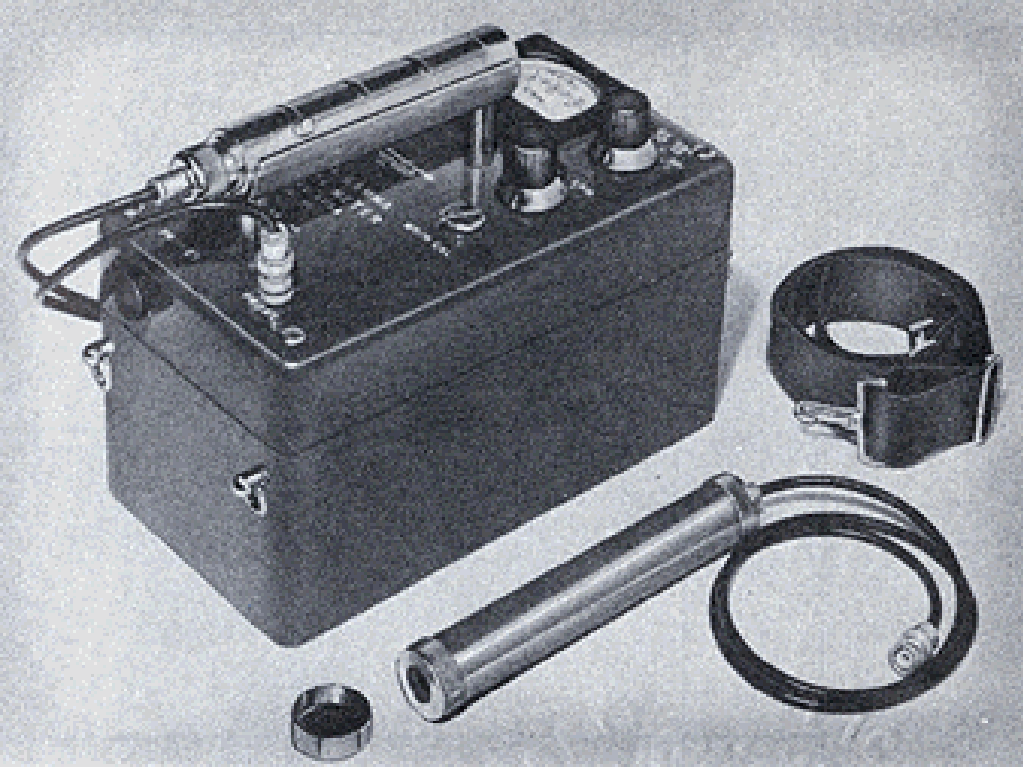
Tracerlab Model SU-5A 1951
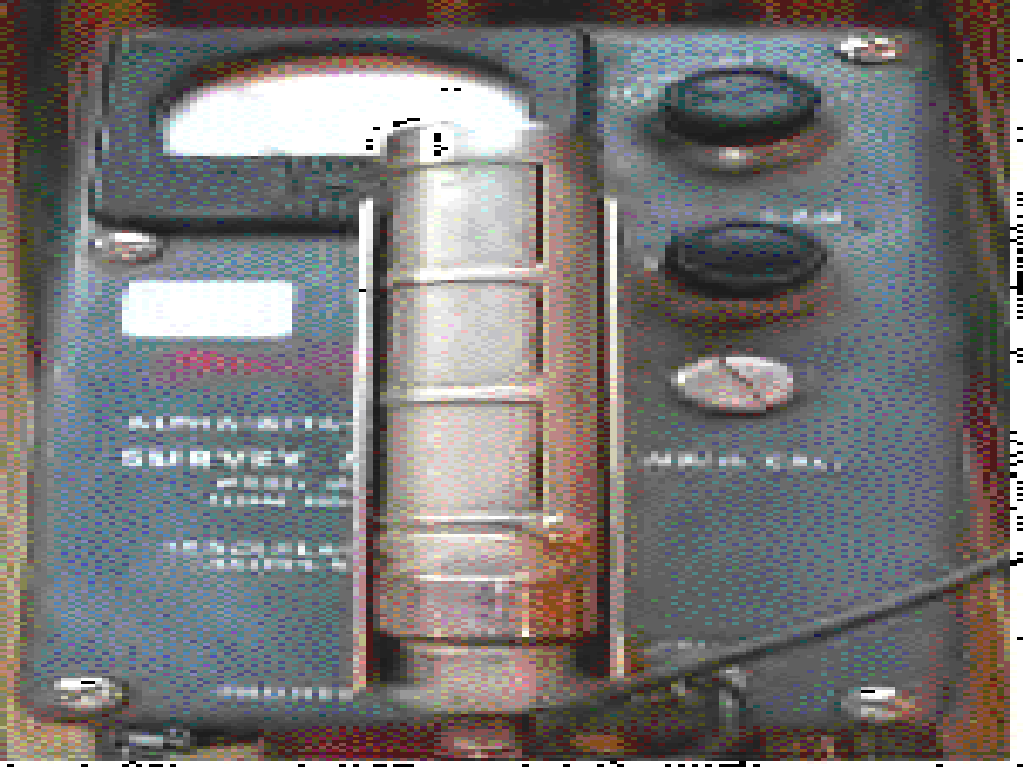
Tracerlab Model SU-5A
The Tracerlab Model SU-6 Pocket Radiac was introduced in 1951 as a Civil Defense instrument. It is an ionization chamber type instrument that has a single logarithmic scale up to 25 R/h. The Model SU-6H had two ranges of 50 and 500 R/h and the Model SU-6L with a single range of 2.5 R. The meter can be operated with one hand by means of a single control knob. It was designed to easily fits in your pocket and uses hearing aid components. The ionization chamber part of the instrument is bright red and the remainder is gray. The unit is housed in a dust proof polystyrene case. The unit was 6 x 2.75 x 1.25. The unit sold for $49.50 to $54.50 depending upon the model.

Tracerlab Model SU-6 Pocket Radiac 1951

Tracerlab Ad 1951
The Tracerlab SU-7 Ore Detector was introduced in 1950 as a portable instrument for locating radioactive ores. The Geiger tube is contained in a waterproof probe in the end of a 36 flexible cable. It is small enough to fit into small crevices and bore holes for exploration. It can be replaced with a large tube if required. The small tube has a background count rate of 10 cpm at sea level. It uses one 1.5, one 22.5 and three 300 volts batteries. The unit is unaffected by moisture and is submersion proof. It will still operate after being submerged over 10 feet in water. The unit had a gray hammertone case with a polished aluminum top plate. The unit weighs 7.5 lbs. and sold for $112.50 in 1950.
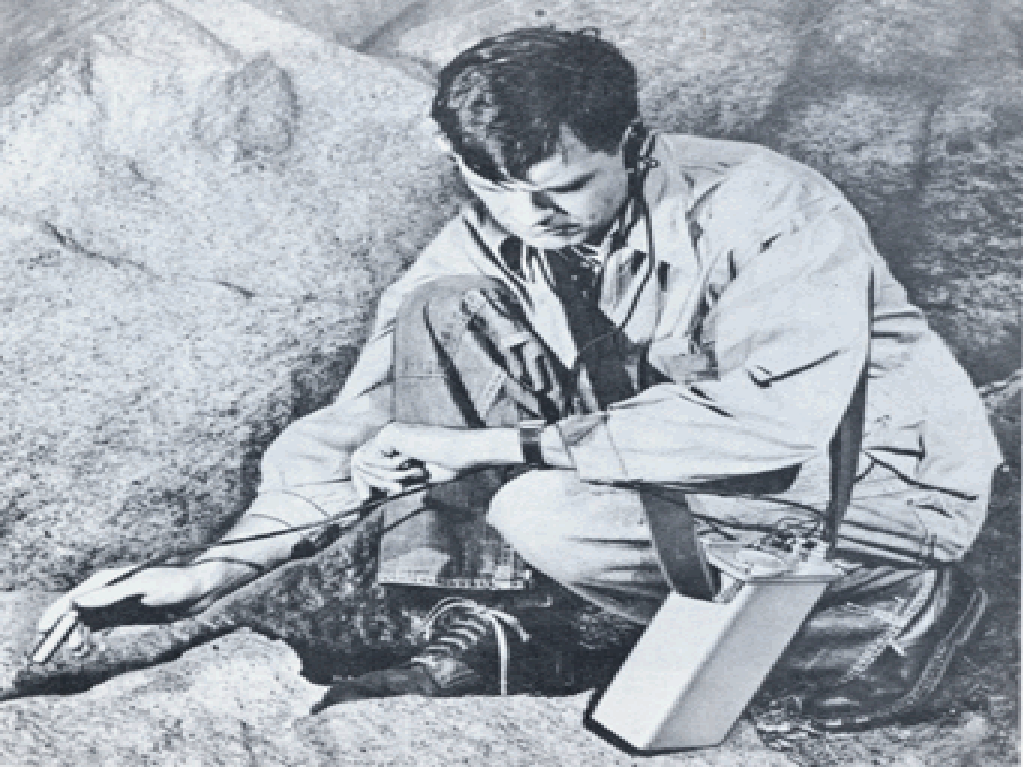
Tracerlab Model SU-7 1950
The Tracerlab Radiac Model SU-10 was introduced in 1951 as a Civil Defense ionization chamber instrument for the military. For Federal Civilian Defense Agency use the unit was bright orange. It was originally marketed by Tracerlab and Kelley-Koett. The term RADIAC stands for Radiation Detection, Indication, And Computation. The SU-10 is the military version of the Juno. It is a gamma ionization chamber with five differently colored ranges from 5 (green-yellow), 50 (white), 500 (yellow), 5,000 (orange), and 50,000 (magenta) mR/h. The bar behind the scale changed color with the scale change. It also had an illumination pushbutton for the meter for night use.
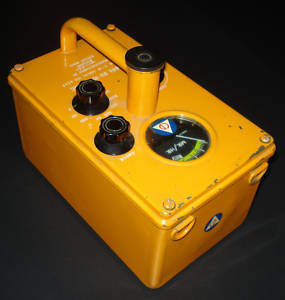
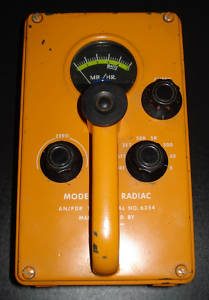
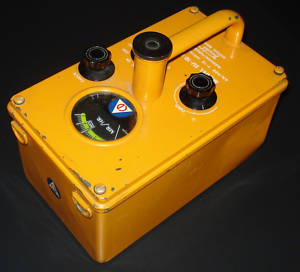
Tracerlab Radiac Model SU-10 Civil Defense
One version of the SU-10 had the characteristic olive green military color. It was designated the AN/PDR-T-1 when introduced in 1950. It is built to Armed Force specifications and approved by the Federal Civilian Defense Agency. It was primarily designed as a Radiac training set for the US Army Signal Corps at Ft. Monmouth, New Jersey. It was upgraded in 1951 and designated the AN/PDR-T-1B. The Model T1-B had two ranges or 5 mR/h and 50 R/h. It is shock proof and immersion proof. It will operate under conditions of extreme temperature and humidity. It has a built in radioactive beta source that was activated by a knob on the control face. The unit was 10 x 6 x 5.5 and weighed 11 lbs. The SU-10 sold for $195.

Tracerlab AN/PDR-T1 Ion Chamber 1953
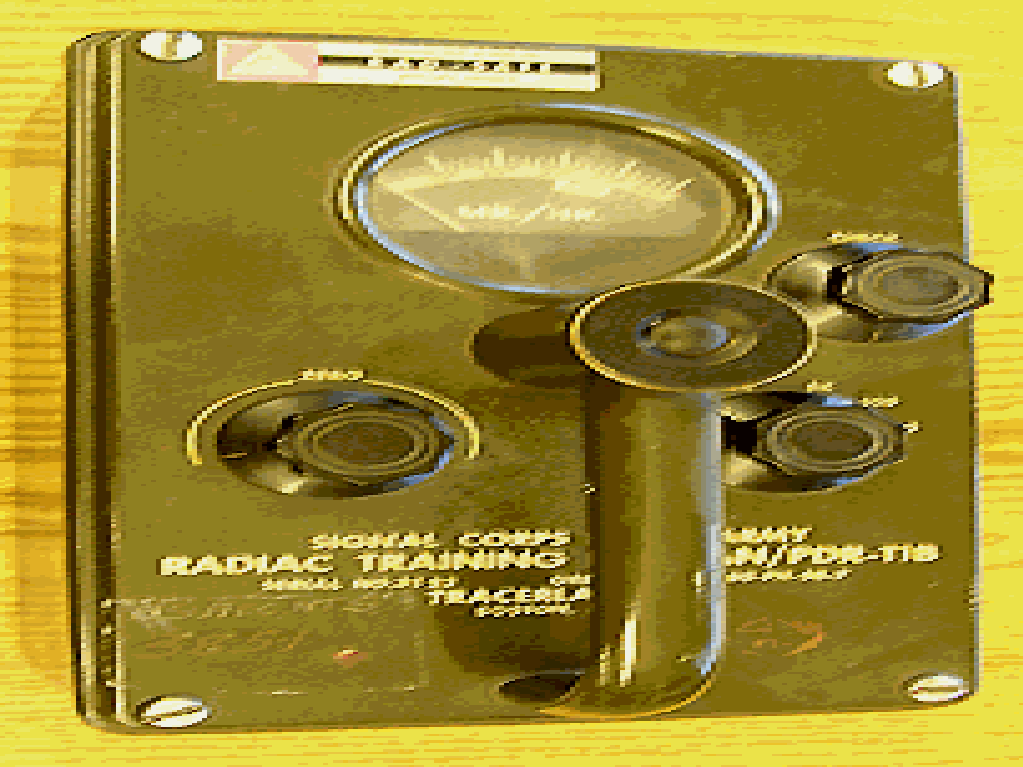
Tracerlab Model AN/PDR-T-1B 1951

Tracerlab Model AN/PDR-T-1B 1951
The Tracerlab High Range Radiac Model SU-13 was introduced in 1951. The high range unit was for Civil Defense work for the hazardous ranges from 0.025 R to 500 R/h. Since the unit was designed for use in hot areas, special care was taken to make it small and light. The unit is 7.5 x 4.5 x 3. The unit has a single logrithmic scale nearly 5 in diameter. It starts at 0.02-500 R/h. It has a push button for meter illumination. It used four 1.5 and two 45 volt batteries. It was bright yellow as designated by the Federal Civil Defense Administration. The SU-13 sold for $120.
Need photo
Tracerlab High Range Radiac Model SU-13 1951

Tracerlab Ad 1951
The Tracerlab Survey Meter Model SU-14 sold for $225-$265 depending upon the probe in 1954. It was a lightweight unit with meter calibrated to 0.25, 2.5 and 25 mR/h. The meter has two GM tubes, one with a slide window and sliding shield for selective monitoring of medium energy beta or gammas, and a second with a thin end window for low energy beta or alpha particles. It also had count rates ranges from 500, 5000, and 50,000. The time constant automatically changed with the range selected. The unit was 9-1/8 x 3.5 x 4.25 with a probe was 1-1/8 x 6-7/8. It had a gasket seal for maximum waterproofing. It used four flashlight and three 45 volt batteries. The probe was attached with a 3-foot coiled retractable cable.
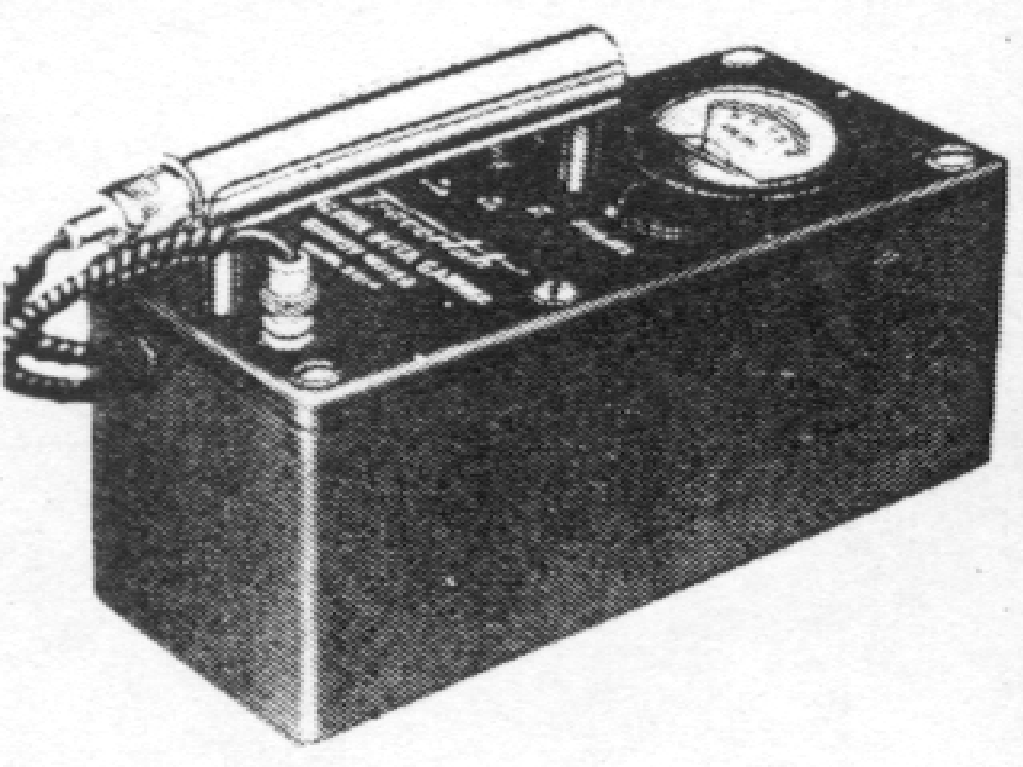
Tracerlab Model SU-14 1954
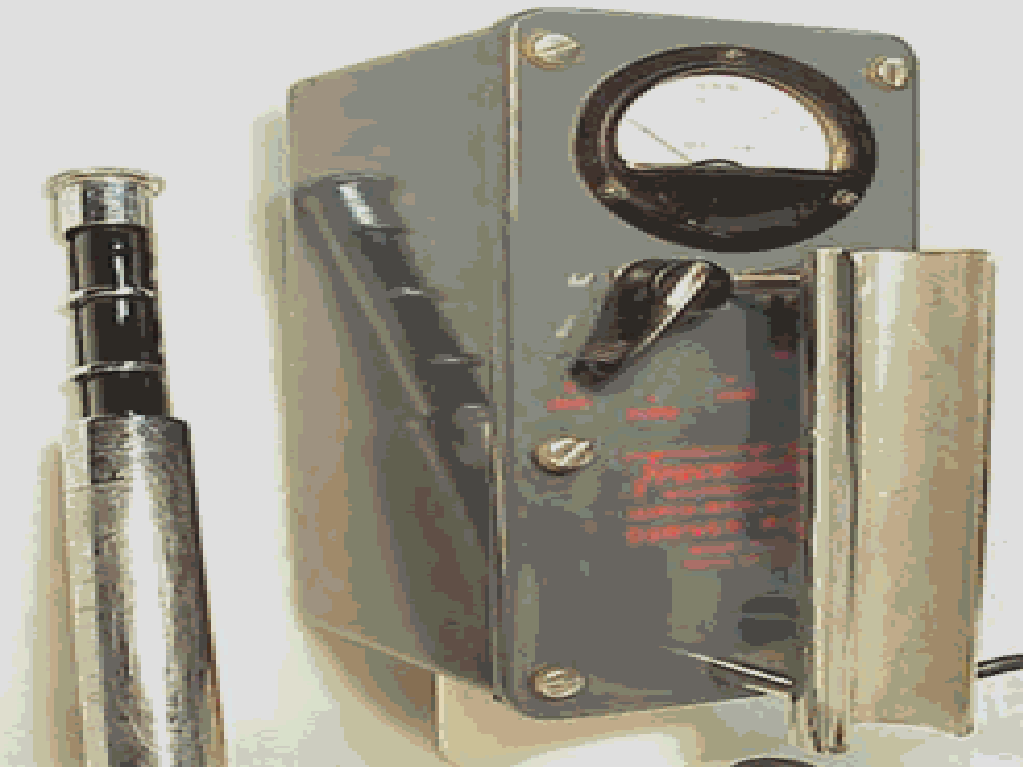
Tracerlab Model SU-14
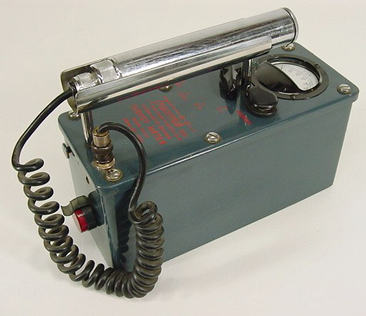
Tracerlab Model SU-14
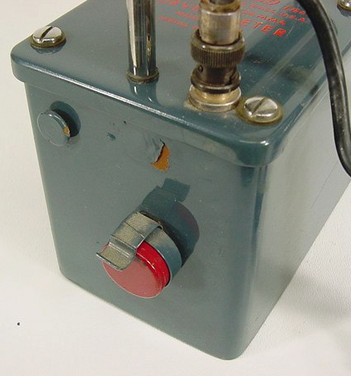
Tracelab Model SU-14 Red Button Radiation Source
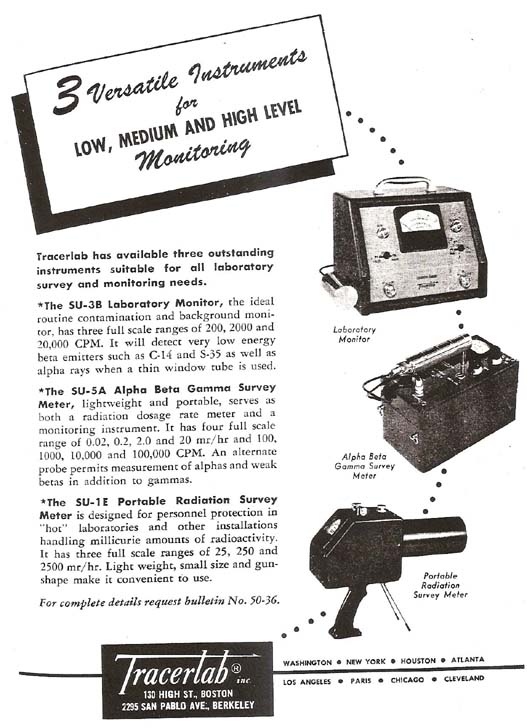
Tracerlab Ad 1953